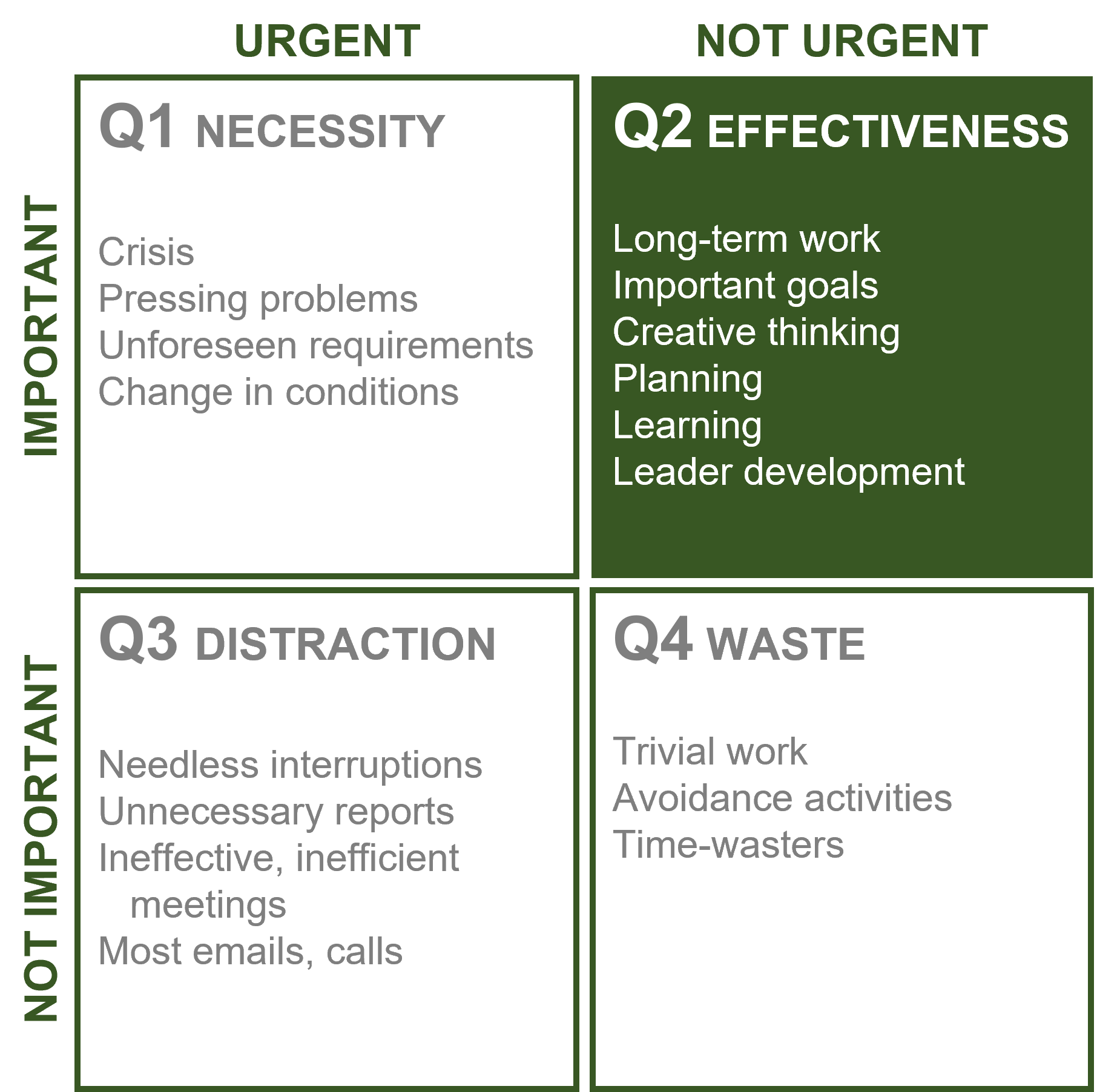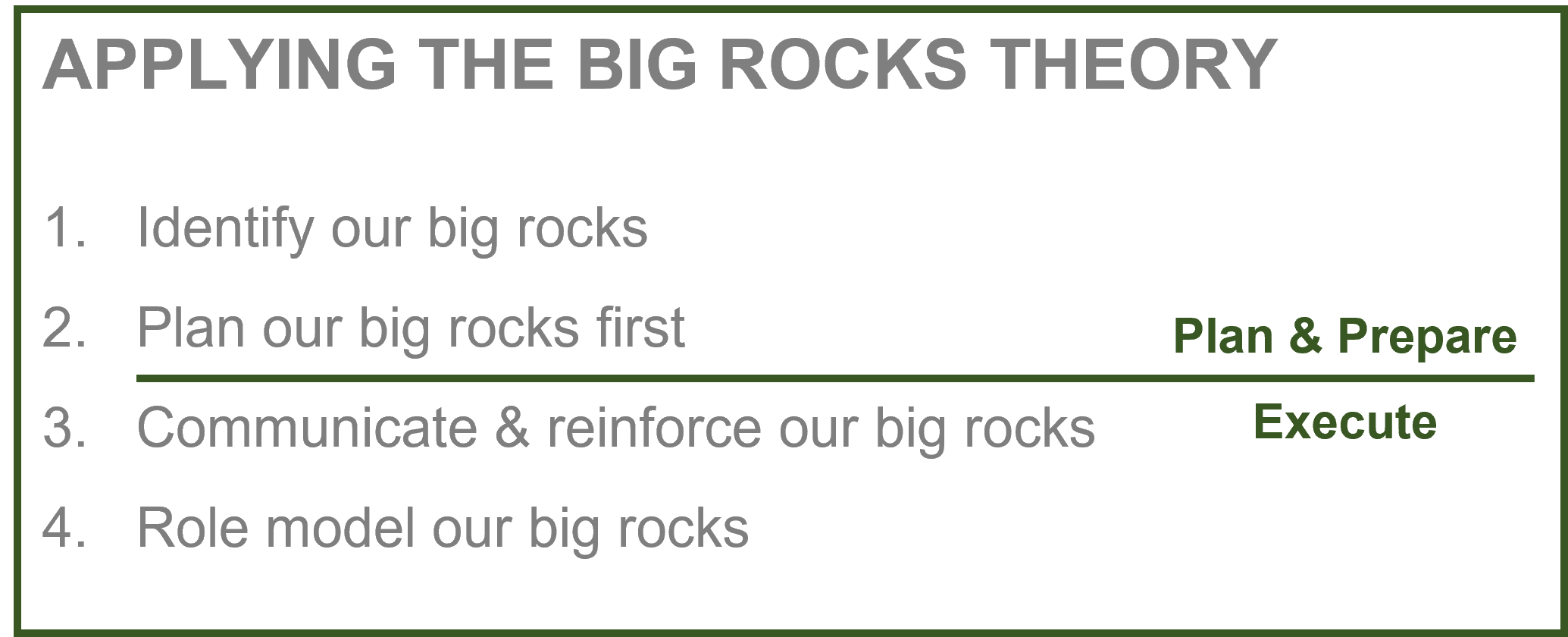Placing the Big Rocks First: Living & Leading with Intentionality

By: Josh
Leaders must provide clarity on what it important...and what is not...for their organization. They set and communicate priorities, eliminate distractions, and ultimately, build capacity for their people.
Prioritization is the act of defining the organization's 'big rocks' and placing them first.
The theory of the big rocks goes like this:
A philosophy professor stood before his class and had some items in front of him. When class began, wordlessly he picked up a large empty mayonnaise jar and proceeded to fill it with rocks right to the top, rocks about 2″ diameter. He then asked the students if the jar was full? They agreed that it was.
So, the professor then picked up a box of pebbles and poured them in to the jar. He shook the jar lightly. The pebbles, of course, rolled into the open areas between the rocks. The students laughed. He asked his students again if the jar was full? They agreed that yes, it was.
The professor then picked up a box of sand and poured it into the jar. Of course, the sand filled up everything else. “Now,” said the professor, “I want you to recognize that this is your life. The rocks are the important things – your family, your partner, your health, your children – anything that is so important to you that if it were lost, you would be nearly destroyed. The pebbles are the other things in life that matter, but on a smaller scale. The pebbles represent things like your job, your house, your car. The sand is everything else. The small stuff. If you put the sand or the pebbles into the jar first, there is no room for the rocks. The same goes for your life. If you spend all your energy and time on the small stuff, material things, you will never have room for the things that are truly most important.
“Take care of the rocks first – the things that really matter.”
The theory of the big rocks calls us to live and lead with intentionality – at work, at home, and in our communities.
Understanding the Impact of the Big Rocks
We seem to remain overwhelmed by life. There is always more to do than time allows. This applies at work, at home, and even in our personal lives like hobbies. I don’t know about you, but I somehow feel behind even in my personal hobbies that I do for simple enjoyment! There are always more urgent things in life than we can sufficiently give attention to.
But what about the important things? Are what we spend our time on truly important – the big rocks? Or are they merely the urgent matters that demand our immediate attention – the sand. What’s the role of the pebbles amidst all this?
To live, lead, and work with intention and achieve what is truly important, we need to clarify what is important versus urgent. An effective way to represent this is a simple 2×2 matrix, which has been commonly attributed to Dwight D. Eisenhower and popularized by Stephen R. Covey in his book, The 7 Habits of Highly Effective People.

This concept can apply at many levels from large organizations, to small teams, to personal time management, even to your family’s activities at home. While the matrix represents Q1 (important-urgent) as necessity that requires leaders’ immediate focus, we ultimately emphasize Q2 (important-not urgent) as the foundation of effectiveness. This is the source of our big rocks and requires us to intentionally schedule it.
What are the things in our life and work that belong in Q2?
How much of our time do we spend in Q2 each week, month, and year?
What quadrant do we actually spend most of our time and attention on? What does that mean?
How to Apply the Theory
The theory of the big rocks asserts that we must deliberately place the big rocks in our jars before the sand or even the pebbles consume it. To do this, we should follow four simple, but important sequential steps as shown below.

The first two steps are separated from the bottom two by a line representing two phases. Phase 1, steps 1 and 2 above the line, address actions to plan and prepare for our future, whatever that may look like. It can be the next year or quarter for our organization, it can be the next year for our family, or it can even be building a weekly personal routine to focus our time and attention. Phase 2, which are steps 3 and 4 below the line, deal with execution. This means the process of actually filling our jar with all our life’s stuff (big rocks, pebbles, and sand).
A few additional notes on each of the steps:
- Step 1: Identify our big rocks. This means bringing clarity to what is explicitly important…and what is not. Inherent to the act of defining our big rocks a commitment to keeping all other things not big rocks. This can require risk assessment, prioritization, and hard decisions. This process, depending on what level we are operating at, can include activities like brainstorming, mind mapping, questioning (the 5x ‘whys’), and feedback seeking.
- Step 2: Plan our big rocks first. If it’s not on the calendar, it’s not getting done. Our big rocks activities must be placed on our calendar before anything else, which means it needs to be scheduled in advance. Do we need to conduct semi-routine planning events to map out our calendar for some window into the future? How far out can we and must we plan to ensure our big rocks are placed in our jar first, remain in the jar, and are not replaced by the immediacy of sand when seemingly urgent matters arise? How often must we do this planning to make it effective and sustainable? This can apply collectively at the organizational level, personally, and within our families at home.
- Step 3: Communicate & reinforce our big rocks. An inherent role of leader is “chief reminding officer.” We must communicate perspective, reinforce purpose, and provide energy in as many ways, scenarios, and to as many people as we can. Do all stakeholders know our big rocks, why they matter, and what we are doing to accomplish them? It can never hurt to talk about it just a little more. No one ever quit a team or job because their boss overcommunicated with them.
- Step 4: Role model our big rocks. We cannot identify, schedule, and communicate our big rocks and then not actually do them. Commit to our schedule; don’t sacrifice planned events to “urgent” needs unless crisis requires it. Moreover, we cannot expect others in our organization or family to commit to our big rocks if we do not ourselves. If, for example, being a learning organization is one of our big rocks and conducting after-action reviews (AARs) following all major projects is a way we achieve that, we must personally engage with in AARs as leaders and role models. By dismissing AARs because we are too busy or because they only apply to the levels below us, we devalue any attempt to make this an actual big rock. We need to walk the talk; our video needs to match the audio.
What Living Out the Big Rocks Theory Looks Like
To complete this exploration of the big rocks theory, let’s look at a few examples of what living this out can look like in our daily life and work:
- Conducting team planning sessions every quarter to identify priorities and placing those priorities on the calendar for the next one to two quarters. Involving stakeholders in this process encourages clarity and commitment across the team.
- Creating a personal “battle rhythm” or daily/weekly routine to give appropriate time and attention to the important things first. This can include placing requirements on your weekly routine first (meetings with bosses or higher headquarters), then blocking times for our big rocks (reflection, creative, learning, production times, etc.). Doing this prevents unimportant urgencies like mountains of emails dominating our attention every and all day. There are days where I process dozens of emails and complete a few to-do items, yet still leave work feeling unaccomplished and that I did not contribute to the organization in meaningful ways.
- Leading routine family meetings to plan how we intend to spend our time, identify and review our big rocks (values, purpose, etc.), and reflect and assess. I recently found a great model for this from a Harvard Business Review article, which can serve as a reference point to adapt off of for our specific family context.
Let’s live and lead with intentionality by placing the big rocks in our jar first.





